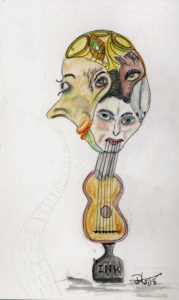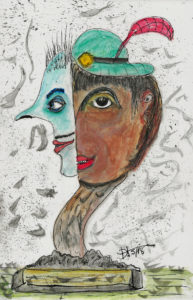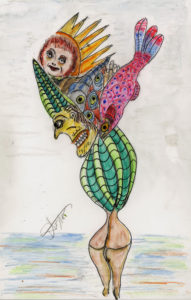Mulvihill Lecture
Click on link
Mulvihill Lecture
Click on link
Mine was a humble arrival in the most famous of America’s boroughs. I entered Park Slope, Brooklyn, New York in a rental car. I had been offered the car free if I would drive it to JFK from Chicago. My liquidity was $600 cash, a backpack of tattered clothes, art supplies, and the promise of an apartment to sit while its occupants were on honeymoon. I would have ten days to find a place to live. It was 1982, the depths of the Reagan recession and eight months shy of my fortieth birthday.
Park Slope was still home to working class Irish and Puerto Ricans, but it was undergoing rapid gentrification. Every week, another real estate company opened on Seventh Avenue, Park Slope’s commercial hub. Mostly the neighborhood consisted of chopped up Gilded Age brownstones, rent-controlled tenements, and abandoned homes repurposed as hangouts for desperadoes and drug addicts. It was a neighborhood in transition, still mostly working class and poor, but the inexpensive housing and proximity to Manhattan were an irresistible magnet for all manner of wannabe twenty-somethings: musicians, artists, illustrators, writers, playwrights, dancers, painters, sculptors, directors, actors, models…. There were a few well-known writers, musicians, and film people living on the Slope, but most incoming residents were ambitious career entrants.
He was the oldest person attending the wedding and reception. His brother Nick, the groom’s father, was only ten months younger than himself. His youngest brother Jack, five years his junior, was still the third oldest person there. Except for the groom’s extended family, the majority of the attendees were equally split between twenty-somethings and early-middle-aged relatives of the groom’s mother. To him the younger women, contemporaries of the bride, all sounded as if they were breathing helium. In addition to high inarticulate voices, their conversations were filled with up-talk, conjunctions conjoined to conjunctions and OMG’s in various flavors.
He was not drinking. He had been dry for three months and this was his first social gathering. He’d flown in from Paris, not so much for the wedding, but to be together with his brothers for probably the last time. The previous time they had all been together was fifteen years ago at their mother’s funeral.
Artist’s Note
The Night Book is a folio of mixed-media paintings: pencil, ink, watercolor, Aquarelle pencil & acrylic. The paintings began as pencil, later ink, drawings made in my bedside Moleskine and Stillman & Birn sketchbooks while in that zone between wakefulness and sleep, A world devoid of reason but rich in images: half-formed, unrelated, surreal, erotic, even terrifying. A critic likened my phantasmagoric paintings to graphic poetry. Inspiration for the Night Book project came from Goya’s Los Caprichos (1799), and from François Desprez’s (1655) and Gustave Doré’s (1854) illustrations for Rabelais’s Pantagruel (1655), in my novel, The Nude Pianist (Fictionaut, 2016), a few of these paintings appear as the work of Francesco Martinelli.
All these drawings are protected by International Copyright. Click on the paintings to enlarge.



Welcome to this third and final installment in my Guest Series on new editions of 17th-century women writers. This last essay discusses an extraordinary figure whose writings are a rich weave of interests, from feminism, politics, and education, to astronomy, astrology, and cosmography. This is none other than the remarkable Margaret Cavendish, Duchess of Newcastle (c1623-1673), a writer of many qualities who took English literature to a whole new level. She owned a telescope. She collected optical lenses. She designed her own haut coutoure. Her visit to the new London Royal Society in 1667 was a sensation. Confident in her abilities and certain of “a glorious Fame”, she published under her own name and her record of publication (plays, poetry, essays, letters, prose fiction, autobiography) was substantial. She described her manuscripts as “paper Bodies”, living things creating “a great Blazing Light” after her death. (An expanding cohort of advocates would say: Yea, she was right!) Her masterpiece and signature work is an astonishing futuristic text, The Blazing-World (London, 1666, 1668), considered the first-ever science fiction novel written and published by a woman writer. It is now available in a new edition for 21st-century readers, prepared by Sara H. Mendelson, a respected scholar on Cavendish and a former president of the Margaret Cavendish Society. Fasten your seatbelts, Duchess Margaret will take you right out of this world. < Click here for essay
This is my first creative non-fiction story. It was published in the multi-media magazine Mad Hatters’ Review (Issue 13, May 2012; homepage). The Butterfly Effect was a designated “Notable Story” by storySouth Million Writers Award.
Click on the magazine cover to hear/read my story. (The printed version is updated from the earlier read version.) Elsewhere in the issue is my music Mouth Parts, performed in Paris by Trio Rare < here >
I have assembled an Excel spreadsheet of all my fiction writings from my first effort in June 2012 to December 2016. The catalog gives the title, date of publication, type of story, genre, publisher, word count and URL for on-line publications. The URLs are not “hot” and will have to be copied and pasted in your browser.
In four and half years, I have published 430,019 words which includes 2 novels, a novella, 29 short stories, 36 flash fictions, 3 micro fictions, an elegy and a poem.
The links to Five Million Yen, The Nude Pianist, and The Judge’s Wife (retitled RASH) are to the current versions. They were all serialized on Fictionaut.
The publisher of PANK asks all the authors to read their stories. I recorded myself reading How Was Your Afternoon, Dear? which was published in the Fall/Winter 2016 issue of PANK magazine online. To hear me read the story with my sound design and music, click here and click on the audio play button.
THE BOOK OF HESTER
EDITING AN UNCANONICAL TEXT
LADY HESTER PULTER: Brotherton MS Lt q32, Leeds UK
By Maureen E. Mulvihill, Princeton Research Forum, NJ
Writer, Guest Series, Old Books / New Editions (2016). Part II of III.
Hosted by Bruce McKinney’s Rare Book Hub, San Francisco
Series announcement, ILAB. Part I of Series, “Anne Killigrew”
Read the complete essay here.